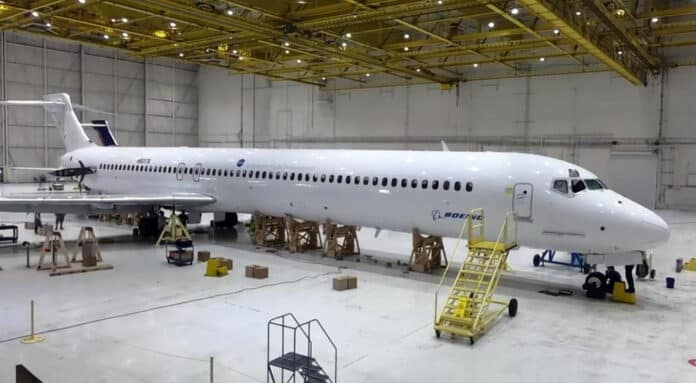Boeing has taken the first steps toward building NASA’s newest X-plane after it began extensive modification of an airplane by removing engines and conducting 3D metrology scans to inform the plane’s design and build plan.
Work to transform an MD-90 into the slender-winged X-66A for NASA‘s Sustainable Flight Demonstrator (SFD) program is underway at Boeing’s facility in Palmdale, California.
Many countries have set ambitious targets to reduce carbon emissions and combat climate change. The aviation industry, responsible for a significant portion of global emissions, is also under pressure to find ways to reduce its carbon footprint. While new technologies like electric motors or hydrogen fuel show promise, they are not yet mature enough to displace existing long-haul flights and cargo transporters.
So, it’s important to focus on reducing emissions from the current technology. NASA’s X-66 project seems to be a step in the right direction toward achieving this goal.
Last year, we reported about NASA’s partnership with Boeing to build a sustainable flight demonstrator (SFD). The two organizations were set to invest $425 million and $725 million in the project, with the aim of reducing fuel consumption and cutting down on emissions per flight by 30%. The proposed changes included building a Transonic Truss-based Wing (TTBW) configuration aircraft and a new propulsion system and aircraft architecture.
In a new release, Boeing highlights taking some initial steps towards building the X-66A, transforming an MD-90 into the slender-winged X-66A. The company is now planning to test the Transonic Truss-Braced Wing (TTBW) design by removing the original wings of the MD-90 jet and replacing them with new ultrathin wings braced by struts with larger spans and higher aspect ratios. This design is expected to result in wider wing spans and greater aerodynamic efficiency, which could significantly contribute to reducing fuel use and emissions in the aviation industry.
Additionally, a time-lapse video has been released by Boeing, showcasing recent progress in the conversion process, which includes jacking and shoring of the jet to simulate the condition of the airplane during full modification, as well as 3D laser scanning of the airplane structure.
With the help of scanning data, Boeing will use 3D modeling software to overlay the existing MD-90 structure with the new X-66 components. This will enable more accurate spatial integration and the possibility to identify and mitigate risks early in the modification process.
The ground and flight testing is expected to begin in 2028. This is NASA’s first experimental plane project solely aimed at achieving the goal of U.S. net-zero aviation greenhouse gas emissions.
